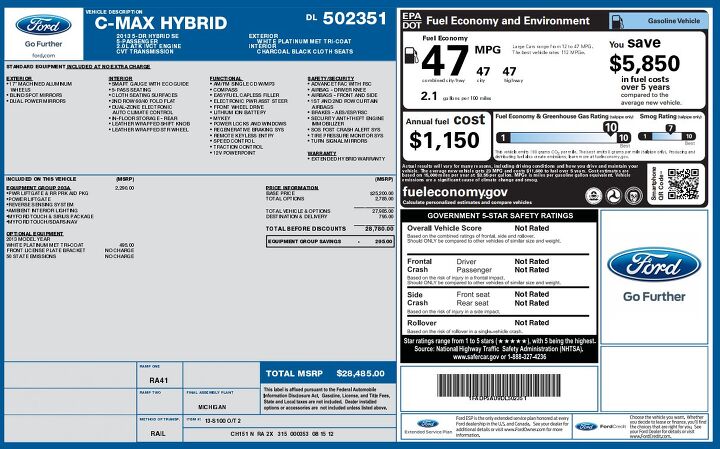EPA: Blame Ford, Not Us, For C-Max Hybrids Not Reaching Mileage Ratings
Following Ford’s announcement that they will revise downward their advertised fuel economy ratings for the C-Max Hybrid, the United States Environmental Protection Agency said that the discrepancy between rated and real world fuel mileage was not the agency’s fault and appeared to be placing the blame on Ford for relying on the agency’s own rules, substituting data derived from the Fusion Hybrid because it shares a drivetrain with the hybrid C-Max. The EPA’s chief automotive regulator, Christopher Grundler, said that when they tested the Toyota Prius and Hyundai Sonata hybrids this summer, “It was fall quite reassuring.”
Grundler told Automotive News “The problem here is really not how the testing is done.” Grundler appeared to have been responding to Ford’s Raj Nair, global head of product development for the Dearborn automaker, who earlier said, “This is an industry wide issue with hybrid vehicles. We’ve learned along with EPA that the regulations create some anomalies for hybrid vehicles under the general label rule.”
Grundler did say that the Agency’s rule that allows very different vehicles that share the same drivetrain and approximate weight to share an EPA mileage rating will need to be changed to avoid the potential of misleading car buyers. He didn’t give a timetable but anticipated that it would take less than a year for the EPA to change the rule.
Toyota joined the EPA in pointing the finger at Ford. “Toyota agrees with EPA that this is a not a hybrid issue, but strictly an issue of how the Ford C-Max Hybrid fuel economy values were determined. We believe the current labeling methodology established since 2006 provides appropriate fuel economy label values for customers, when automakers apply these rules with good common sense and engineering judgment.”
More by TTAC Staff
Latest Car Reviews
Read moreLatest Product Reviews
Read moreRecent Comments
- Slavuta CX5 hands down. Only trunk space, where RAV4 is better.
- Kwik_Shift_Pro4X Oof 😣 for Tesla.https://www.naturalnews.com/2024-05-03-nhtsa-probes-tesla-recall-over-autopilot-concerns.html
- Slavuta Autonomous cars can be used by terrorists.
- W Conrad I'm not afraid of them, but they aren't needed for everyone or everywhere. Long haul and highway driving sure, but in the city, nope.
- Jalop1991 In a manner similar to PHEV being the correct answer, I declare RPVs to be the correct answer here.We're doing it with certain aircraft; why not with cars on the ground, using hardware and tools like Telsa's "FSD" or GM's "SuperCruise" as the base?Take the local Uber driver out of the car, and put him in a professional centralized environment from where he drives me around. The system and the individual car can have awareness as well as gates, but he's responsible for the driving.Put the tech into my car, and let me buy it as needed. I need someone else to drive me home; hit the button and voila, I've hired a driver for the moment. I don't want to drive 11 hours to my vacation spot; hire the remote pilot for that. When I get there, I have my car and he's still at his normal location, piloting cars for other people.The system would allow for driver rest period, like what's required for truckers, so I might end up with multiple people driving me to the coast. I don't care. And they don't have to be physically with me, therefore they can be way cheaper.Charge taxi-type per-mile rates. For long drives, offer per-trip rates. Offer subscriptions, including miles/hours. Whatever.(And for grins, dress the remote pilots all as Johnnie.)Start this out with big rigs. Take the trucker away from the long haul driving, and let him be there for emergencies and the short haul parts of the trip.And in a manner similar to PHEVs being discredited, I fully expect to be razzed for this brilliant idea (not unlike how Alan Kay wasn't recognized until many many years later for his Dynabook vision).


































Comments
Join the conversation
I would presume that the problem is that the EPA test cycle is too short to accurately calculate the mileage of the CMAX and Fusion. Ford's system differs from Toyota. Ford's setup relies more heavily on battery-only operating modes. Longer drives will deplete more battery power, which would cause the gas engine to operate more during the later part of a given drive than at the beginnning. The EPA city test starts with a cold engine and covers 11 miles. The highway test has a hot engine and covers 10.3 miles. The other supplementary tests are similarly short. Presumably, the tests are conducted with a fresh battery. I would bet that the results would be different if the test cycles were similar to what they are now, but covered longer distances, such as 50+ miles each. A longer test should remove some of the variation that comes from the battery's varying states of charge. Toyota's system makes more use of the gas engine. That makes the results more predictable, since the EPA test is measuring gasoline usage, not total energy usage. That's not necessarily better or worse, but it does make for more accurate testing.
Ford has now adjusted its C-Max EPA numbers to 45 city, 40 highway and is sending current owners a check for $550. The C-Max' fuel economy is HIGHLY dependent on driving style. It is quite possible to reach or exceed the EPA numbers. In town the trick is to accelerate slowly & maximize regenerative braking. On the interstate the car will get about 43 MPG cruising at 69 MPH -- any faster than that and mileage drops down into the high 30s. I routinely get mileage in the mid-50s on around-town drives, this is where the car really shines.